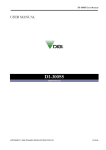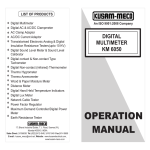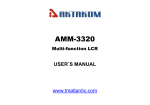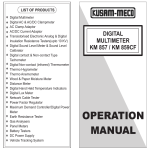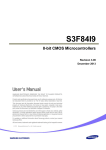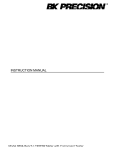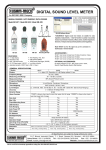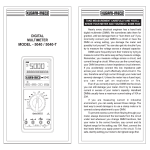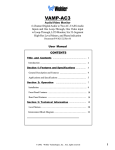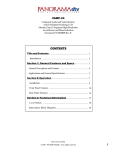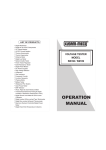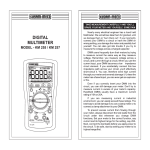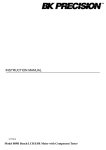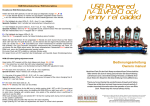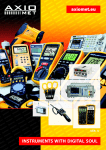Download operation manual operation manual - Kusam Electrical Industries Ltd.
Transcript
LIST OF PRODUCTS * * * * * * * * * * * * * * * * * * * * * * * * * * * * Digital Multimeter Digital AC & AC/DC Clampmeter AC Clamp Adaptor AC/DC Current Adaptor Transistorised Electronic Analog & Digital Insulation Resistance Testers(upto 10 KV) Digital Sound Level Meter & Sound Level Calibrator Digital contact & Non-contact Type Tachometer Digital Non-contact (infrared) Thermometer & Portable Infrared Calibrator Thermo Hygrometer / Anemometer Digital Absolute pressure meter Wood, Paper & Grain Moisture Meter Distance Meter & Network Cable Tester Digital Hand Held Temperature Indicators Digital Lux Meter Thermal Imaging Camera Power Factor Regulator Maximum Demand Controller/Digital Power Meter Earth Resistance Tester Digital Panel Meters & DC Power Supplies Digital Storage / Analog Storage Oscilloscope. Coating Thickness Guage Process Calibrators & Multifunction Calibrators Gas Analysers & Waterproof Pen Testers Frequency Counter / Function Generator Phasing Sticks & High Voltage Detector Transducer & Transmitter Digital Milli Ohm Meter Solar Power Meter EMF/ELF Detector / RF Field Strength Meter 17, Bharat Industrial Estate, T. J. Road, Sewree (W), Mumbai-400015. INDIA Sales Direct: 24156638 Tel.:(022)2412 4540, 2418 1649 Fax:2414 9659 E-mail : [email protected], Website : www.kusamelectrical.com, www.kusam-meco.co.in Multi-Function LCR MODEL KM 520B OPERATION MANUAL Thank you for purchasing the multi-function LCR meter. Please take a few minutes to browse through this user manual before you begin to operate the meter to ensure that you are fully familiarized with how best to operate the meter as accurately and safely as possible. Overview This multi-function LCR meter is a portable instrument designed with microprocessor control and low power consumption. It can measure 6 basic parameters: inductance L, capacitance C, AC resistance R, DC resistance DCR, dissipation factor D and quality factor Q. The instrument can easily communicate with PC and realize remote control through USB interface. With battery external power supply, the meter is ideal for field and portable applications, such as component inspection at fixed place, and immediate measurement by maintenance personnel. Cautions = This instrument can only be used in indoor. = Be sure to turn off the instrument when replacing the battery or DC power adapter. = Although the instrument has a protection for shocks, inputing dc voltage or current will still damage the = If the instrument is idle for more than 15 days please take the batteries out. = Use AAA * 6 batteries. The instrument can not work properly when low battery voltage indication appears. = In order to ensure the measurement accuracy, open / short calibration should be carried out again after replacing the test fixtures. = Do not using the instrument under dusty, vibration, direct sunlight and corrosion gas. environment Introduction Features = 19,999/1,999 counts dual LCD display = Basic accuracy : 0.3% with resolution of 0.01% = Analog bar display = Measurement frequency up to 100KHz = Mini-USB interface = Auto LCR smart check and measurement = Sorting function = Relative measurement = Data hold, = Back light, full angle for LCD display = 4-terminal measurement configuration = Automatic power off = Battery and external power supply = Battery voltage indication. instrument. The capacitance requires completely discharge before measuring. 1 2 Specifications Specifications DCR : DC resistance Ls/Cs : series inductance / Primary capacitance Lp/Cp : parallel inductance / capacitance Parameters q : phase angle D: dissipation factor E SR: equivalent series Secondary resistance Q : quality factor RP: equivalent parallel resistance Frequency 100/120/1K/10K/100KHz Display Dual display + analog bar display 100/120Hz 20mH ~ 20KH 1KHz 2000m H ~ 2000H L 10K 200m H ~ 20H 100KHz 20m H ~ 200mH 100/120Hz 20nF ~ 20mF 2000pF ~ 2mF 1KHz Measurement 200pF ~ 200m F C 10K range 200pF ~ 20m F 100KHz ~ 200MW 100/120Hz 200W 20W ~ 200MW 1KHz R 20W ~ 20MW 10K 100KHz 20W ~ 2MW DCR 200 ~ 200M D/Q 0.001 ~ 1999 q 0.00° ~ ± 180.0° Test Level 0.6 Vrms Range mode Auto and Hold Equivalent Parallel and Series circuit 3 Calibration function Interface Measurement speed Open / Short Mini - USB Approx. 1.2 times/second Measurement terminal 4-terminal Basic accuracy Power 0.3% AAA*6 battery or external power supply Auto Power off Operating Environment 5 min (with batteries) temperature 0°C ~ 40 °C humidity £ 90%RH (40°C no condensation Storage temperature -25°C ~ 50 °C Impedance Accuracy Ae The below - listed accuracies are guaranteed by the meter with normal use under the operating temperature of 18°C -28°C and relative humidity less than 80% 4 Note :- All accuracy is guaranteed by proper ratio resistor calibration and open/short calibration. Explanation on Front Panel 1 If D > 0.1, the accuracy should be multiplied by 1+D2 2 ZC = 1 , if D << 0.1 in capacitance mode 2p fc ZL = 2p f L, if D << 0.1 in inductance mode 3 8 7 6 SORTING PC LINK HOLD Sub-display parameters accuracy : Ae = impedanze (Z) accuracy. 11 10 9 4 FUNC. SET UP SERPAL DQESR 14 13 12 REL% FREQ. 1 Definition : Q = D 5 CAL. ENTER 15 Press 2 sec Rp = ESR (or Rs) x (1+ 1 ) D2 1) D value accuracy : De = ± Ae x (1+D) INPUT RX LX CX GUARD GUARD 16 LCUR Hpot Lpot HCUR 2) ESR accuracy : Re = ± ZM x Ae (W ) i.e., ZM = impedance calculated by 1 or 2p fL 2p fc 3. Phase angle q accuracy : q e = ± (180 / p ) x Ae (deg) Note :- D : Q : ESR : Rp : dissipation factor quality factor equivalent series resistance equivalent series parallel resistance q: phase angle 5 Figure 1 The front panel is shown as figure 1. 1) Mini USB interface :- Connect with PC, easily for data transmission and management. 2) LCD :- Used for displaying the measuring results and various symbols. 3) key :- Used for putting ON or OFF the operating power for the meter. 4) Func. Key :- When Func. key is pressed, the main test mode could be selected sequentially: Auto-LCR mode-Auto-L mode-Auto-C mode-Auto-R mode-DCR mode-Auto-LCR mode. 6 5) CAL key :- Used to do OPEN/SHORT calibration. 6) SORTING key :- Press this key to enter into sorting mode, which could help the user to make a quick sort for a bunch of components. 7) PC LINK key :- Press this key to communicate 15) ENTER key :- In sorting mode, press ENTER key to confirm the data modification. 16) Measurement terminal The instrument has 4-terminal measurement configuration, as shown in figure 2. with PC. GUARD 8) HOLD key :- Used to maintain the measurement data unchanging, by pressing the key again it will resume the measurement. INPUT Rx Lx Cx GUARD Grounding (shielding) Excitation positive terminal LCUR LPOT H POT HCUR 9) D/Q/ESR key :- In L/C measurement mode, press the key to select parameters of D/Q/q /ESR. 10) SETUP key :- When sorting mode is active, press SETUP key to modify the reference value, range and the tolerance setting sequentially. Measurement positive terminal Measurement negative terminal Excitation negative terminal Figure-2 Understanding Display Screen 11) SER/PAL key :- Used to select series and parallel mode. 12) FREQ key :- Press FREQ key to select five different test frequencies in turn : 100/120/1K/ 10K/100KHz 13) REL% key :- Press REL% key to enter into relative measurement mode. In auto LCR mode, this key is not available. 14) key :- By pressing this key for once, the backlight of the LCD screen will be turn ON and after 60 seconds the meter will automatically turn off the backlight. It is also possible to turn off the backlight by pressing this key before the 60 seconds. 7 Figure-3 LCD screen is shown as in Figure 3, with its every symbol's meaning shown as in the Table 1: 8 NO. MEANING NO. MEANING 1 Auto power off indication 2 Data hold 3 Auto mode indication 4 Auto LCR mode indication 11 Sub-display 12 Analog bar indication 13 The meter is in the data transmission mode. 14 battery indication (with battery supply) 5 Range indication 6 Relative Measurement mode 15 Frequency indication 16 Tolerance range 7 Main-display 17 Sorting mode indication 8 Unit for main parameters 18 External power supply 9 Secondary parameters 19 Open/Short calibration mode indication 10 Unit for secondary parameters 20 Primary parameters Operating instruction Power on the meter Press key to turn ON the power. The default mode is AUTO LCR smart mode and the default test frequency is 1kHz. When key is pressed during power-on mode, the instrument will enter power-off mode. The LCD will show the "OFF" state before power off. Function Descriptions 1) Parameters setting Press FUNC. key to select the following parameters sequentially : AUTO LCR, L-Q, C-D, R, DCR. Parameter AUTO-LCR L-Q C-D R DCR MEANING Auto LCR smart mode Inductance measurement, the parameter on sub-display is quality factor Q Capacitance measurement, the parameter on sub-display is dissipation factor D. Resistance measurement DC resistance measurement mode 9 L/C/R measurement readings can be positive or negative. In C-D measurement, If the main parameter is "-", the actual component being tested is inductive; In L - Q measurement, if the main parameter is "-", the actual component being tested is capacitive; Theoretically, R is positive, in some cases, R is "-", which may be calibration error, please re-calibrate the instrument. 2. Auto LCR smart Mode The default test mode is Auto LCR mode which could check the type of impedance smartly. If I q I < 11°, the Auto - R mode is selected. The parameter on sub - display is q . If q > 11°, the Auto - L mode is selected. The parameter on sub - display is Q. If q < -11°, the Auto - C mode is selected. The parameter on sub - display is D. If the C < 5pF, the parameter on sub-display is parallel resistance Rp. Note : In order to avoid damaging the instrument, the capacitance requires discharge before measuring. 3. Frequency setting Press FREQ key to select frequency value : 100/120/ 1K/10K/100KHz. The LCR impedance scale ranges are depended on the test frequency. 4. Data Hold Press this key to hold the measurement data and press it again to resume the measurement. 10 5. Relative mode During relative measurement the meter remembers the current readings on primary display (called initial value) when pressing the REL% key, and "REL" symbol appears on LCD. The secondary display will show the percentage of relative value REL% b) When using LCUR / LPOT / HPOT /HCUR terminals insert the black and red testing lines with alligator clip into the "LCUR "," LPOT ",terminal and " HCUR ", "HPOT terminal respectively. (shown in figure 5). GUARD LCUR INPUT Rx Lx Cx LPOT H POT GUARD GUARD HCUR LCUR INPUT Rx Lx Cx LPOT H POT GUARD HCUR The REL% = (present value - initial value) / initial value * 100%. Press REL% key again to show the current readings on primary display and the "REL" symbol will be blinking. The percentage range is from -99.9% ~ 99.9% when the present value is larger than double of initial value, the "OL%" indication will be shown on the secondary display. During relative measurement, analog bar is always indicating the present measurement value but not the relative value. 6. Open / Short calibration 1) Press CAL key larger than 2 seconds to start the open / short calibration procedure. 2) In open calibration mode, the secondary display will show "Open". There are two ways for open state input: Figure 4 Figure 5 3) Press CAL key and the 30-second countdown will be shown on LCD panels. If the open calibration is finished, the PASS or FAIL symbol will be shown on the primary display. Press CAL key again to save the calibration data and enter into the short calibration mode. 4) In short calibration mode, the secondary display will show "Srt". There are two ways for short state input: a) When using square terminals, insert the short soket to the square terminal and make LCUR / LPOT / HPOT /HCUR terminals hang in the air (shown in figure 6); a) When using square terminals, the square terminals and LCUR / LPOT / HPOT /HCUR terminals hang in the air (shown in figure 4); b) When using LCUR / LPOT / HPOT / HCUR terminalsinsert the black and red testing lines with alligator clip into the " LCUR"," LPOT",terminal and " HCUR ", "HPOT". terminal respectively. Connect the mouth of clips (shown in figure 7). 11 12 7. Equivalent Circuit SHORT GUARD LCUR GUARD LPOT H POT GUARD HCUR LCUR Figure 6 INPUT Rx Lx Cx LPOT GUARD H POT HCUR Figure 7 5) Press CAL key and the 30-second countdown will be shown on LCD panels. If the short calibration is finished, the PASS or FAIL symbol will be shown on the primary display. Press CAL key again to save the calibration data. Note: 1) To get the better accuracy, the open / short calibration should be done before measurement. 2) The purpose of open / short calibration is to reduce the parasitic effect of the test fixture. 3) Open or short circuit, is selected automatically according to the measurement terminal. 4) In short calibration, there may be FAIL situations, which may be caused by not using the low resistance short line or unreliable contact, please try again after reliable short - circuit When any L/C/R functional mode is selected, the default measurement in series or parallel mode is auto selected and the AUTO segment will be shown on LCD display. It depends on the total equivalent impedance measured. If the impedance is larger than 10KW , parallel mode is set and Lp/Cp/Rp is shown on the display. If it is less than 10KW , series mode is set and Ls/Cs /Rs is shown on the display. When SEL/PAL key is pressed, the impedance measurement will be set in series mode on in parallel mode sequentially. Note :- The actual capacitance, inductance and resistance is not ideal component of pure reactance and pure resistance. Usually the resistance and reactance exist simultaneously. A practical impedance can be simulate by the ideal resistors and ideal reactor (inductor or capacitor) in series or parallel form. 8. Sorting mode The sorting mode could help the user to make a quick sort for a bunch of components. The setting step as following: 1) Accordings to the component type, press FUNC, key to select L, C or R measurement mode. 2) Insert the standard component into the input therminal, Press SORTING key to enter into the sorting mode and the "Sorting" symbol appears on LCD. If the LCD reading is OL or less than 200 counts, the SORTING key is not available. 13 14 3) When sorting mode is active, press SETUP key to modify the range, reference value and the tolerance settings sequentially. 4) "Range" symbol is flashing when setting the range. Press D/Q/ESR ( ) key to shift the decimal point, unit to left and press SER/PAL ( ) key to right. Press ENTER key to confirm and enter into the reference value setting mode automatically. At this time, "Range" symbol disappear. 5) When setting the reference value, press D/Q/ESR ( ) key and SER/PAL ( ) key to shift the bit to left and right respectively. Press PCLINK ( ) key and REL % ( ) key to make the digit +1 or -1. The flashing bit is the current setting bit. The reference value setting is available from 20 to 1999 counts. Press ENTER key to confirm and enter into the tolerance setting mode automatically. 6) When setting the tolerance, press D/Q/ESR ( ) key & SER/PAL key to select tolerance range : ± 0.25% ± 0.5% ±1% ±2% ±5% ±10% ±20% ± 80%-20%. The default tolerance is ±1%. Press ENTER key to confirm. 7) After setting the parameters, remove the standard component and insert the component to be measured. If the impedance measured does not exceed tolerance range, the primary display will show "PASS", otherwise show "FAIL". The current measurement result will be shown on the secondary display. 15 8) Press SORTING key again to exit the sorting mode. Note: In AUTO LCR mode, the SORTING key is not available. 9. PC-LINK mode Press PCLINK key "USB" symbol appear on LCD. Connect the instrument to PC through USB interface, and the measured data can be recorded, analyzed, processed and printed by PC. Press PCLINK key again to cancel the data transmission. Then USB symbol disappears. Due to the power consumption in data transmission, please exit USB mode when there is no need to transmit data. Operating step 1.Inductance measurement 1) Turn on the power. 2) There are two ways for inductance input: a. Insert the inductance to be measured into the input terminal directly (shown in figure-8); b. Connect the alligator clips to the ends of the inductance to be measured (shown in figure-9). 3) The default test mode is Auto LCR mode, the inductance value will be shown on primary display and the quality factor Q will shown on secondary display. In Auto LCR mode, the D/Q/ ESR key, SEL / PAL key, SORTING key and REL% key are not available 16 4) Press FUNC. key to select Auto-L-mode. The primary LCD display will show the quality factor Q. The equivalent resistance ESR/Rp, phase angle q or dissipation factor D can also be shown by pressing the D/Q/ESR key. 5) Press FREQ key to select frequency value: 100/ 120 /1K/10K/100KHz. 6) Press SER/PAL key to select series or parallel mode. GUARD LCUR INPUT Rx Lx Cx LPOT H POT GUARD GUARD HCUR LCUR INPUT Rx Lx Cx LPOT GUARD H POT HCUR 4) The default test mode is Auto LCR mode, the capacitance value will be shown on primary display and the dissipation factor D will be show on secondary display. In Auto LCR mode, the D/Q/ESR key, SEL/PAL key, SORTING key and REL% key are not available. 5) Press FUNC. key twice to select Auto-C mode. The primary LCD display will show the capacitance value. The secondary LCD display will show the dissipation factor D. The quality factor Q, equivalent resistance ESR/Rp or phase angel q can also be shown by pressing the D/Q/ESR key. 6) Press FREQ key to select frequency value: 100/ 120 /1K/10K/100KHz. 7) Press SER/PAL key to select series or parallel mode. Figure 8 Figure 9 2. Capacitance measurement 1) Turn on the power. 2) If voltage exists in the capacit or connect the two ends of the capacitors for a short time to discharge. 3) There are two ways for capacitance input: a. Insert the positive polarity of capacitance into the positive terminal and its negative polarity into the negative terminal (shown in figure 10); b. Insert the black and red testing lines with alligator clip into the "LCUR", "LPOT", terminals and "HCUR", "HPOT", terminal respectively. Connect the alligator clips to the ends of capacitance corresponding to its polarity (shown in the figure 11). Note :- 1) When Auto-LCR mode is active, the secondary parameter will show the equivalent resistance in parallel mode (Rp) to replace the D factor if the C measured value is less than 5pF. 2) In order to avoid damaging the instrument, the capacitance requires discharge before measuring GUARD LCUR INPUT Rx Lx Cx LPOT H POT GUARD GUARD HCUR LCUR Figure 10 17 INPUT Rx Lx Cx LPOT GUARD H POT Figure 11 18 HCUR 3. Resistance measurement 1) Turn on the power. 2) There are two ways for resistance input: a. Insert the resistance to be measured into the input terminal directly (shown in figure-12); b. Connect the alligator clips to the ends of the resistance to be measured (shown in figure-13). Note : The phase angle q will show on secondary display only in Auto-LCR mode. During Auto-R mode or DCR mode, the secondary parameter is not available. GUARD LCUR 3) The default test mode is Auto LCR mode, the resistance value will be shown on primary display and the phase angle q will be shown on secondary display. In Auto LCR mode, the D/Q/ ESR key, SEL/PAL key, SORTING key and REL % key are not available 4) Press FUNC. key three times to select Auto-R (ACR) mode, The primary LCD display will show the resistance value. The secondary parameter is omitted and the D/Q/ESR key. is not available. 5) Press FREQ key to select frequency value: 100/120 /1K/10K/100KHz. 6) Press SER / PAL key to select series or parallel mode. 7) Press FUNC. key four times to select DCR mode. The primary LCD display will show the resistance value. The secondary parameter is omitted and the D/Q/ESR key, SEL/PAL key and FREQ key are not available. GUARD INPUT Rx Lx Cx LPOT H POT GUARD HCUR LCUR Figure 12 INPUT Rx Lx Cx GUARD H POT LPOT Figure 13 To use Adapter (Under external power adapter, the automatic power off function is not available). Connecting the power adapter: 1) Connect the AC power cord to the AC-DC converter 2) Plug the AC power cord into an electrical outlet (100V-240V). 3) Plug the DC power plug of the convertor into DC power socket of the meter DC power DC power Socket Plug AC-DC Converter. AC/DC adapter information: Input : 100V-240VAC, 50-60Hz 1.8A Output : DC 12V 2A MAX Polarity : + - 19 HCUR 20 AC power Cord WARNING: 1) Please use the original AC power adapter, using other AC power adapter may damage your instrument. 2) The AC power adapter can only be used indoors. 3) Please plug the AC power cord into an electrical outlet first and then firmly insert DC plug into DC input end in the right of the meter. When unplugged, firstly pull out the DC plug perpendicular to DC input end and then unplug the AC plug from the electrical outlet. 4) Do not use the AC power adapter in other equipment except this instrument. 5) In use, it is a normal phenomenon that the AC power adapter will be hot. 6) Do not demolish the AC power adapter. Otherwise, it may be dangerous 7) Do not use the AC power adapter in a high temperature or wet place. 8) Please make the AC power adapter avoid a strong bump. 9) It is normal when the AC power adapter make some noise in use. Replacing the Battery :- Please change the battery when the battery symbol is less than one segment. Turn off the power of the instrument. When you change the battery, and screw off the breechblock on the battery cabinet cover, then take off it and replace with fresh battery. ACCESSORIES = User manual. = AAA batteries = Shielding clip line = Kelvin 4-terminal measure line = Short socket = USB line (USB model only) = PC-Link software CD (USB model only) If there are some changes in accessories, please refer to the real products as standard. Note : To get the better accuracy, when using LCUR/LPOT/ HPOT/HCUR/ terminal measured with the alligator clip-testing lines, Please insert the open soket to the square terminals (shown in figure 14). OPEN GUARD GUARD MAINTENANCE Cleaning :- Periodically wipe the case with a damp cloth do not use abrasives or solvents. Calibration :- Calibrate your instrument once a year to ensure that it performs according to its specifications. 21 One piece Six piece One piece One piece One piece One piece One piece LCUR LPOT H POT Figure 14 22 HCUR WARRANTY MUMBAI Each “KUSAM-MECO” product is warranted to be free from defects in material and workmanship under normal use & TEST CERTIFICATE service. The warranty period is one year (12 months) and begins from the date of despatch of goods. In case any defect occurs in functioning of the instrument, under proper use, within Multifunction LCR the warranty period, the same will be rectified by us free of charges, provided the to and fro freight charges are borne by you. This Test Certificate warrantees that the product has been inspected and tested in accordance with the published specifications. This warranty extends only to the original buyer or end-user customer of a “KUSAM-MECO” authorized dealer. This warranty does not apply for damaged Ic’s, burnt PCB's, fuses, disposable batteries, carrying case, electrodes probes, cables or to any product which in “KUSAM-MECO’s” opinion, has been misused, altered, neglected, contaminated or damaged by accident or abnormal conditions of operation or handling. 520B MODEL NO. KM __________ “KUSAM-MECO” authorized dealer shall extend this warranty on new and unused products to end-user customers only but have no authority to extend a greater or different warranty on behalf of SERIAL NO. ___________ “KUSAM-MECO”. “KUSAM-MECO’s” warranty obligation is limited, at option, free of charge repair, or replacement of a defective product which is DATE: ___________ returned to a “KUSAM-MECO” authorized service center within the warranty period. THIS WARRANTY IS BUYER’S SOLE AND EXCLUSIVE REMEDY AND IS IN LIEU OF ALL OTHER WARRANTIES, EXPRESS OR IMPLIED, INCLUDING ISO 9001 REGISTERED QC BUT NOT LIMITED TO ANY IMPLIED WARRANTY OF MERCHANTABILITY KUSAM-MECO OR FITNESS FOR A PARTICULAR PURPOSE. “KUSAM-MECO” SHALL PASS NOT BE LIABLE FOR ANY SPECIAL, INDIRECT, INCIDENTAL OR CONSEQUENTIAL DAMAGES OR LOSSES, INCLUDING LOSS OF DATA, ARISING FROM ANY CAUSE WHATSOEVER. All transaction are subject to Mumbai Jurisdiction. 23 24













